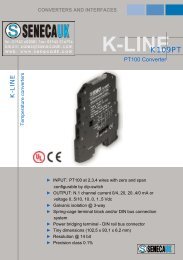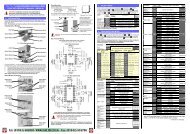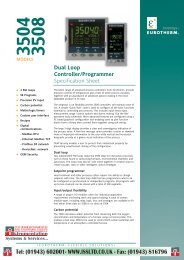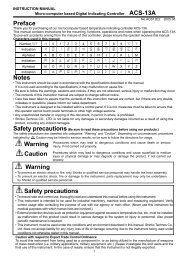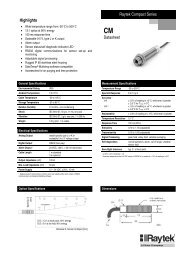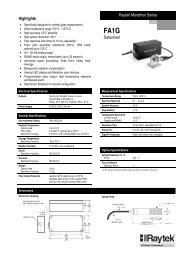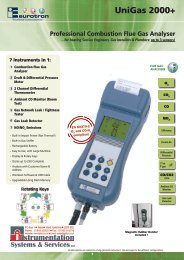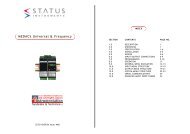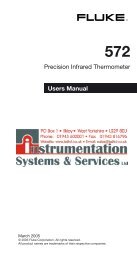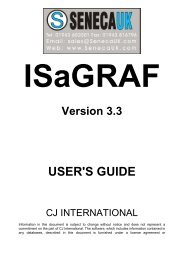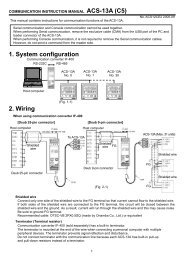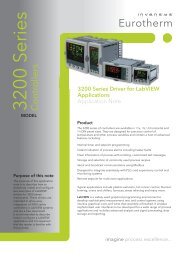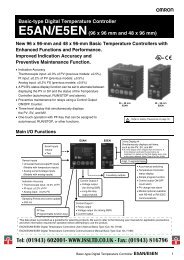to download the Eurotherm piccolo⢠Manual in PDF format
to download the Eurotherm piccolo⢠Manual in PDF format
to download the Eurotherm piccolo⢠Manual in PDF format
Create successful ePaper yourself
Turn your PDF publications into a flip-book with our unique Google optimized e-Paper software.
Piccolo Range<br />
3.1 Installation Safety Requirements<br />
Safety Symbols<br />
Various symbols may be used on <strong>the</strong> controller. They have <strong>the</strong> follow<strong>in</strong>g mean<strong>in</strong>g:<br />
User <strong>Manual</strong><br />
Refer <strong>to</strong> manual. Risk of electric shock. Take precautions aga<strong>in</strong>st static.<br />
C-tick mark for Australia (ACA) and New Zealand (RSM).<br />
Complies with <strong>the</strong> 40 year Environment Friendly Usage Period.<br />
<br />
RoHS<br />
Restriction of Hazardous Substances<br />
Protected by DOUBLE ISOLATION.<br />
☺ Helpful h<strong>in</strong>ts<br />
Personnel<br />
Installation must only be carried out by suitably qualified personnel <strong>in</strong> accordance with <strong>the</strong> <strong>in</strong>structions <strong>in</strong> this<br />
manual.<br />
Enclosure of Live Parts<br />
To prevent hands or metal <strong>to</strong>ols <strong>to</strong>uch<strong>in</strong>g parts that may be electrically live, <strong>the</strong> controller must be enclosed <strong>in</strong> an<br />
enclosure.<br />
Caution: Live sensors<br />
The controller is designed <strong>to</strong> operate if <strong>the</strong> temperature sensor is connected directly <strong>to</strong> an electrical heat<strong>in</strong>g<br />
element. However you must ensure that service personnel do not <strong>to</strong>uch connections <strong>to</strong> <strong>the</strong>se <strong>in</strong>puts while <strong>the</strong>y are<br />
live. With a live sensor, all cables, connec<strong>to</strong>rs and switches for connect<strong>in</strong>g <strong>the</strong> sensor must be ma<strong>in</strong>s rated for use <strong>in</strong><br />
230Vac +15% CATII..<br />
Wir<strong>in</strong>g<br />
It is important <strong>to</strong> connect <strong>the</strong> controller <strong>in</strong> accordance with <strong>the</strong> wir<strong>in</strong>g data given <strong>in</strong> this guide. Take particular care<br />
not <strong>to</strong> connect AC supplies <strong>to</strong> <strong>the</strong> low voltage sensor <strong>in</strong>put or o<strong>the</strong>r low level <strong>in</strong>puts and outputs. Only use copper<br />
conduc<strong>to</strong>rs for connections (except <strong>the</strong>rmocouple <strong>in</strong>puts) and ensure that <strong>the</strong> wir<strong>in</strong>g of <strong>in</strong>stallations comply with all<br />
local wir<strong>in</strong>g regulations. For example <strong>in</strong> <strong>the</strong> UK use <strong>the</strong> latest version of <strong>the</strong> IEE wir<strong>in</strong>g regulations, (BS7671). In <strong>the</strong><br />
USA use NEC Class 1 wir<strong>in</strong>g methods.<br />
Power Isolation<br />
The <strong>in</strong>stallation must <strong>in</strong>clude a power isolat<strong>in</strong>g switch or circuit breaker. This device should be <strong>in</strong> close proximity <strong>to</strong><br />
<strong>the</strong> controller, with<strong>in</strong> easy reach of <strong>the</strong> opera<strong>to</strong>r and marked as <strong>the</strong> disconnect<strong>in</strong>g device for <strong>the</strong> <strong>in</strong>strument.<br />
Overcurrent protection<br />
The power supply <strong>to</strong> <strong>the</strong> system should be fused appropriately <strong>to</strong> protect <strong>the</strong> cabl<strong>in</strong>g <strong>to</strong> <strong>the</strong> units.<br />
Voltage rat<strong>in</strong>g<br />
The maximum cont<strong>in</strong>uous voltage applied between any of <strong>the</strong> follow<strong>in</strong>g term<strong>in</strong>als must not exceed 230Vac +15%:<br />
• relay output <strong>to</strong> logic, dc or sensor connections;<br />
• any connection <strong>to</strong> ground.<br />
The controller must not be wired <strong>to</strong> a three phase supply with an unear<strong>the</strong>d star connection. Under fault conditions<br />
such a supply could rise above 264Vac with respect <strong>to</strong> ground and <strong>the</strong> product would not be safe.<br />
Conductive pollution<br />
Electrically conductive pollution must be excluded from <strong>the</strong> cab<strong>in</strong>et <strong>in</strong> which <strong>the</strong> controller is mounted. For<br />
example, carbon dust is a form of electrically conductive pollution. To secure a suitable atmosphere <strong>in</strong> conditions<br />
of conductive pollution, fit an air filter <strong>to</strong> <strong>the</strong> air <strong>in</strong>take of <strong>the</strong> cab<strong>in</strong>et. Where condensation is likely, for example at<br />
low temperatures, <strong>in</strong>clude a <strong>the</strong>rmostatically controlled heater <strong>in</strong> <strong>the</strong> cab<strong>in</strong>et.<br />
This product has been designed <strong>to</strong> conform <strong>to</strong> BSEN61010 <strong>in</strong>stallation category II, pollution degree 2. These are def<strong>in</strong>ed<br />
as follows:-<br />
Installation Category II (CAT II)<br />
The rated impulse voltage for equipment on nom<strong>in</strong>al 230V supply is 2500V.<br />
Pollution Degree 2<br />
Normally only non-conductive pollution occurs. Occasionally, however, a temporary conductivity caused by<br />
condensation shall be expected.<br />
Part No HA031260 Issue 1 May-12 19



